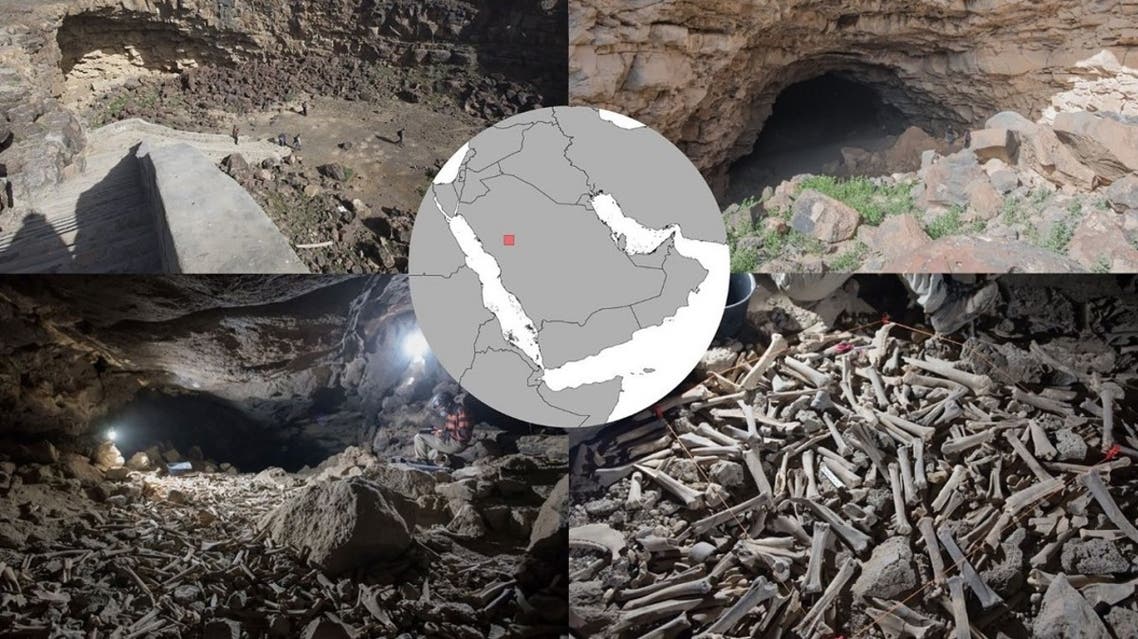Scientists discover hundreds of thousands of animal, human bones in Saudi Arabia cave
Relics 02:13 PM - 2021-08-01
Photo Credit: Stewie Stewart
Scientists have discovered hundreds of thousands of animal and human remains in a cave in northwestern Saudi Arabia, which they believe were gathered by striped hyenas over the past 7,000 years.
For the latest headlines, follow our Google News channel online or via the app.
The discovery was made in the Umm Jirsan lava tube, a 1.5-kilometer tunnel filled with “beautifully preserved” remains located in the Kingdom’s Harrat Kaybar lava field, the scientists wrote in a published study.
The discovery included bones of cattle, caprids, horses, camels, rodents, and even humans.
The accumulation of the bones over thousands of years shows that the lava tube makes for “excellent conditions for preservation of bone,” scientist Stewie Stewart said in a Twitter thread.
“In a region where bone preservation is very, very poor, sites like Umm Jirsan offer an exciting new resource,” he added.
The scientists were able to conclude that the remains were brought in by stiped hyenas based on their studies of the types of bones, frequencies and locations.
“These critters are avid collectors of bones, which they transport to dens to be consumed, fed to young, or cached,” Stewart said.
Despite the study focusing on hyenas, the scientists concluded in their published article that “donkeys have been an important livestock in the region for thousands of years.”
“Umm Jirsan (and other similar sites in the region) is likely to hold valuable insights into the ecologies and environments of Holocene Arabia. This study is just the tip of the iceberg,” Stewart said.
PUKmedia / Al-Arabiya News
More news
-
German Forces Commander Ended his Mission at Mam Jalal's Grave
12:28 PM - 2024-04-23 -
Golden Bla Awards Ceremony Takes Place in Sulaymaniyah
11:32 AM - 2024-04-23 -
PUK Official: PUK is Committed to Holding Elections on Time
11:04 AM - 2024-04-23 -
Turkish President Meets Kurdish Officials in Erbil
10:42 AM - 2024-04-23
see more
DPM Talabani Asks Turkish President to Lift Ban on Sulaymaniyah Airport
11:43 AM - 2024-04-23
Iraqi & Turkish Presidents: Problems Should Be Resolved Through Dialogue
05:00 PM - 2024-04-22
PUK President: We Will Protect Journalists' Rights
03:10 PM - 2024-04-22
DPM Talabani: We Will Defend Freedom of Press
10:26 AM - 2024-04-22
Most read
-
DPM Talabani Asks Turkish President to Lift Ban on Sulaymaniyah Airport
Kurdistan 11:43 AM - 2024-04-23 -
Turkish President Meets Kurdish Officials in Erbil
Kurdistan 10:42 AM - 2024-04-23 -
Türkiye Seeks Surge in Trade Volume with Iraq
Economy 10:21 AM - 2024-04-23 -
PUK Official: PUK is Committed to Holding Elections on Time
P.U.K 11:04 AM - 2024-04-23 -
Golden Bla Awards Ceremony Takes Place in Sulaymaniyah
Kurdistan 11:32 AM - 2024-04-23 -
10 Notable Individuals Receive Golden Bla Award
Kurdistan 09:27 PM - 2024-04-23 -
German Forces Commander Ended his Mission at Mam Jalal's Grave
P.U.K 12:28 PM - 2024-04-23



.jpg)


 Application
Application


